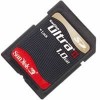SanDisk SDSDH-1024 Product Manual - Page 119
Introduction, Timing - review
 |
UPC - 710348911073
View all SanDisk SDSDH-1024 manuals
Add to My Manuals
Save this manual to your list of manuals |
Page 119 highlights
Host Design Considerations: NAND MMC and SD-based Products Application Note Revision 1.0 Introduction SanDisk's MultiMediaCard (MMC) and Secure Digital (SD) Card have been designed into a wide variety of consumer electronic products: MP3 players, cell phones, PDAs, digital still and video cameras, data loggers, and more. Although these cards were designed to support this wide range of products, there are many options an engineer needs to consider before designing a card slot into a product. Design considerations include how the end product handles timeout delays, bus type selection, block mode selection, and other options. These can have a major impact on the performance and compatibility of the product. This Application Note will review these options and provide recommendations on the optimum way to manage them. Timing There are important timing issues for the engineer to consider when designing products that integrate the MultiMediaCard and/or SD Card. Timing specifications Design engineers must meet the rise, fall, setup, hold, and other SD Card and MultiMediaCard bus timing specifications. If they want to support MultiMediaCards in their design, the clock speed should be controllable by the host. This is due to the MultiMediaCard's open-drain mode; the MultiMediaCard powers up in the open-drain mode and cannot handle a clock faster than 400 Khz. Once the MultiMediaCard completes the initialization process, the card switches to the push-pull mode. In the pushpull mode the MultiMediaCard can run at the maximum clock speed. Refer to www.mmca.org and www.sdcard.org for timing specifications published by MultiMediaCard and SD Card Associations. Read access and program times Read access and program times are also very critical to the proper operation of a product design. If the time-out values for read access and program time are not met, data read from and written to the card may be incorrect or invalid. MultiMediaCard and SD Card manufacturers have different read and write time-out values, and the designer must ensure that the product time-out value is not set below the maximum specification. © 2002 SanDisk Corporation 3 9/30/02, Lit# 80-11-00160














